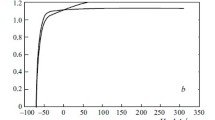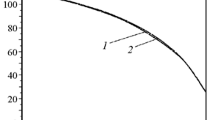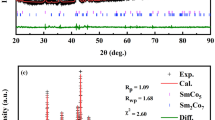Conclusions
Quenching in a magnetic field has a beneficial effect: It increases the coercive force of a magnet from a SmCo5 alloy powder. Thermomagnetic treatment results in “freezing” of magnetic and phase- and-structure changes in magnets.
Similar content being viewed by others
Literature cited
J. S. Jacobs, “Magnetic materials and applications in quarter-century overview,”50, No. 11, 7294–7306 (1979).
Yu. M. Pyatin (ed.), Permanent Magnets (Handbook) [in Russian], Energiya, Moscow (1980), pp. 6–8.
G. G. Gnesin (ed.), Sintered Materials for Electrical Engineering and Electronics (Handbook) [in Russian], Metallurgiya, Moscow (1981), pp. 284–304.
V. V. Sergeev and T. N. Bulygina, Hard Magnetic Materials [in Russian], Energiya, Moscow (1980).
C. Graham, “Thermomagnetic treatment,” in: Magnetic Properties of Metals and Alloys [Russian translation], IL, Moscow (1961), pp. 374–409.
D. Manfred and I. G. Smeggil, “Some observations of the magnetic properties of fluid quenched Co5Sm magnets,” IEEE Trans. Magnetics,9, No. 3, 168–171 (1973).
E. Nesbitt and J. Wernick, Permanent Magnets Based on Rare-Earth Elements [Russian translation], Mir, Moscow (1977).
Ya. G. Bogatin et al., “Method for the metallographic investigation of alloys of the samarium-cobalt system,” Elektron. Tekh. Mater., No. 6, 3–7 (1973).
Ya. G. Bogatin, E. G. Povolotskii, and Yu. I. Surov, “Crystal structure of sintered magnets from an SmCo5 alloy powder,” Elektron. Tekh. Mater., No. 10, 34–37 (1974).
Ya. G. Bogatin, “Investigation of the crystal structure and magnetic properties of the intermetallic compound SmCo5 and permanent magnets from it,” Author's Abstract of Candidate's Dissertation, Volgograd (1976).
Ya. G. Bogatin et al., “On the phase transformations in the compound SmCo5,” Summaries of Papers to the Sixth All-Union Conference on Permanent Magnets [in Russian], Informelektro, Moscow (1979), pp. 23–28.
K. K. Kindzoku, “Method of manufacture of permanent magnets from a rare-earth element and cobalt,” Jpn. Pat. No. 5-13878.
Author information
Authors and Affiliations
Additional information
Translated from Poroshkovaya Metallurgiya, No. 7 (259), pp. 37–42, July, 1984.
Rights and permissions
About this article
Cite this article
Bogatin, Y.G., Zemchenkov, V.S. & Povolotskii, E.G. Effect of quenching in a magnetic field on the structure and properties of sintered magnets from an SmCo5 alloy powder. Powder Metall Met Ceram 23, 525–529 (1984). https://doi.org/10.1007/BF00792121
Received:
Issue Date:
DOI: https://doi.org/10.1007/BF00792121




